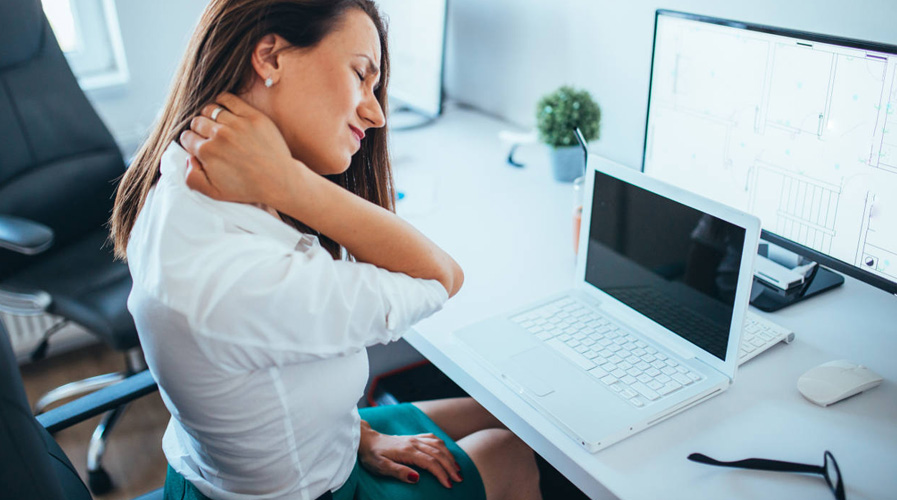
As the covid19 crisis continues, we are looking at another few weeks, if not months, of working from home. Sitting in front of a computer all day can wreak havoc on your body, especially if you do not take adequate breaks. Most of us do not have the ideal ergonomic set up and stay in the same position for hours, hunched over a laptop or on the phone – so is it any wonder that aches and pains are creeping in?
There are several bad habits we pick up when sitting at a desk for too long. Slouching, hunching our shoulders, craning our necks, twisting our torso and crossing our legs. Sound familiar? All of which create pressure on our spine and can cause misalignment. In addition to physical pain, sitting badly can also affect your mood. When hunched over, your lungs are squeezed by the contracted position which decreases your breathing volume. You take in around 30% less oxygen which means less energy and decreased focus.
At home, trying to find a desk space that can fit your computer monitor or laptop may be difficult. A lot of clients I have spoken to sit at their kitchen table, on the sofa and one or two on their bed. This is unadvisable as there is little support for your spine, and this will lead to muscular discomfort. If possible, try to adhere to the following:
- Keep your monitor just below horizontal visual axis, one arm’s length away so that your eyes are looking at the top third of your screen.
- Place arms so that elbows are at a 90-degree angle letting your forearms rest without raising your shoulders.
- Keep your hips, knees and ankles at 90 degrees when seated
- Feet are flat on the ground
- Use a chair with some lumbar support (a cushion would work)
- Use a standing desk set up as another option
In addition to the above and perhaps more importantly, you need to move throughout the day. Walking away from your screen, stretching and breathing in some fresh air is vital. I often tell my clients to stand on their doorstep for 5 mins and just breathe. It is incredibly therapeutic and makes a big difference to your mental state.
I have put together 8 key stretches/flexibility exercises which will help manage pain and stiffness. I would advise doing them 2-3 times a day and holding each stretch for 15 seconds. Over time you will notice less tightness and more productivity. The following can be done either seated or standing.
- Chest stretch – Perfect antidote to slouching! Lace your fingers behind your back, straighten your arms, keep your chest proud and upright.
- Shoulder shrugs – the shoulders hold a lot of tension from typing, clicking and being on the phone. Lift your shoulders up towards your ears and release. Repeat 10 times
- Upper back stretch – stretch your arms out, palms facing away and lean forward
- Spinal twist – this is great for your lower back and you only need to rotate slightly to feel the stretch. Rotate torso with hands on chair handles, left then right.
- Torso stretch – lace fingers together and stretch them up towards the ceiling. Reach as high as you can then open the arms and sweeping them back down.
- Forearm stretch – forearms can get tight from typing. Stretch your arms out, turn your hand down and use the other hand to gently pull fingers towards you.
- Neck stretch – holding tension in the neck leads to headaches and many of us drop our head forward when working on a device. Sit straight and tilt your head gently to each side
- Seated hip stretch – To open up the hips, place your right shin on top of your left thigh. Repeat on the other side.
I am more than happy to demonstrate these stretches so please contact me to set up a meeting if you think it will help.






